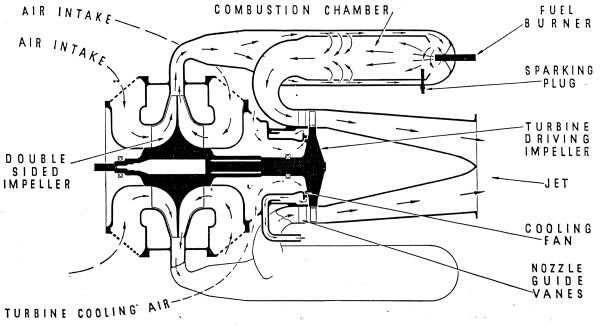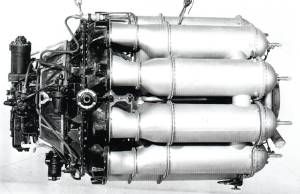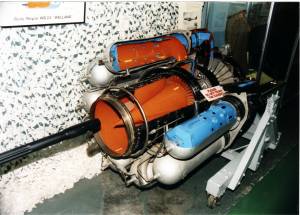
The Whittle/Rover W2B
and Rolls-Royce W2B/23 Welland Turbo-Jets
by Peter Berry
 |
| Diagram of the W2B or B23 |
 |
| Rolls-Royce W2B/23 Welland turbojet that powered the Gloster F.9/40 DG202/G test bed and the early Gloster Meteor Mk.1 and Mk.3 RAF fighters in 1944. (Rolls-Royce WNP.3663) |
The W2B was the Rover version of the Whittle engine, ordered into production by the British Ministry of Aircraft Production in 1942. This "reverse-flow", 43.5-inch diameter engine, featured a 19-inch, double-sided impeller, 10 "reverse-flow" combustion chambers and a single-stage turbine. Engine weight was some 850 lb.
To improve the "surging" problem found at altitude, Maurice Wilks and his staff at Rover, Barnoldswick in Lancashire, developed 20-vane diffusers to Whittle’s design. With the thrust still at 1,000 lb, Mr. J.P. Herriot from A.I.D. came to Rover and with improved turbine material, achieved a 25-hour test at 1,250 lbT in November, 1942.
From July 10, 1940, test pilot Jerry Sayer, was only able to make taxiing runs with 1,200 lbT Rover W2B/23 turbo-jets fitted to the first twin-engined Gloster F.9/40 prototype fighter, DG202/G.
The Rover W2B turbo-jet was first flown in the tail of a twin-engined Wellington test-bed, Z8570/G, from Hucknall, on August 9, 1942.
The deteriorating relations between Power Jets and Rover led to the transfer, in early 1943, of the production of W2B engines at Barnoldswick to Rolls-Royce. Rover handed over a total of 32 W2B engines to Rolls-Royce as well as four "straight-through" W2B/26 engines, developed by Adrian Lombard.
The first flight of the second, single-engined Gloster E.28/39, W4046/G, fitted with a Rover W2B/#110 turbo-jet, was made from Edgehill airfield by John Grierson on March 1, 1943. From April 16, 1943, flight tests continued with a 1,526 lbT W2B/#101 installed in W4046/G. On May 3, this aircraft was flown to the RAE at Farnborough and the following day, flights were made powered by a Rolls-Royce W2B. Flying continued with Farnborough test pilots until June 20, when a Rolls-Royce W2B/#141 was installed.
Following the twisting of the turbine blades by 5°, the W2B passed its 100-test at 1,600 lb on May 7, 1943.
The Rover W2B/#101 engine was re-fitted to W4046/G for further flights, but on July 30, when passing 37,000 feet in a ceiling climb, test-pilot Sqdn. Ldr. Davie, found the ailerons had frozen (by ice) and W4046/G entered an inverted spin. Davie was thrown from the cockpit at 33,000 feet, becoming the first jet pilot to abandon his aircraft in flight! He lost his goggles, a glove and his oxygen mask and only survived by sticking the tube of his emergency oxygen supply into his mouth. He suffered severe frostbite, taking twenty-seven minutes to descend by parachute, landing safely at nearby town of Guildford.
 |
This turbo-jet was the first British production engine. The prototype F.9/40, DG202/G, powered by Rolls-Royce 1,700 lbT W2B/23 engines, was flown by Michael Daunt, from Barford St. John airfield on July 24, 1943. In November this aircraft was delivered to the Rolls-Royce base at Hucknall for Welland development.
Two Rolls-Royce Welland turbo-jets were installed in the first production Meteor Mk.1, EE210/G, which was test flown by Michael Daunt on January 12, 1944. This Meteor was then sent to the United States in exchange for a General Electric J31-GE-powered Bell YP-59 Airacomet, RG362/G. The Meteor was first flown at Muroc AFB by John Grierson on April 15. Several test flights followed. By December, the Meteor had been shipped back to the U.K.
The Rolls-Royce Welland entered service with the RAF Meteor Mk.1 jet fighters EE211-229 and Meteor Mk.3/EE230-244. The first of these Meteors was delivered to No.616 Squadron RAF in May 1944, equipped with 1,600 lbT engines rated at 180-hours between overhauls. Flying from RAF Manston, near the English channel, the Squadron first saw action against the V-1 flying-bombs en-route to London on July 27, 1944. The first of thirteen V-1s to be destroyed was on August 4, when Flying Officer Dean used his wing tip to tip a V-1 off its course and saw it crash onto open ground.
From October 1943, a total of 167 Wellands, were dispatched from the Rolls-Royce facility at Barnoldswick. These were the last of the Whittle "reverse-flow" turbo-jets, but the design continues today in many smaller turbo-fan, turbo-prop and turbo-shaft engines.